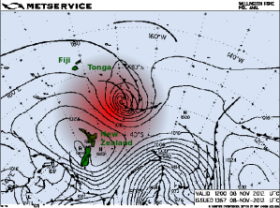Honorable mention: Stay or Go?
Exactly a year after leaving Beaufort, North Carolina for the Caribbean, we faced a similarly tricky passage on the other side of the world. Now in Tonga with an idyllic season of Pacific cruising behind us, we were watching for a weather window to make the 1100 mile trip to New Zealand. The symmetry was striking. A year earlier, our challenge was to find a gap between successive lows coming off North America in November, preferably with cooperative northerlies to ease our way across the Gulf Stream. And no late season tropical storms, please! In Tonga, we warily eyed lows spinning eastward off Australia – southern hemisphere lows spinning clockwise, that is. Again, timing was everything. Too early in the season meant that potential gales south of 30°S would be at their peak; too late, and we could be chased by an early cyclone above that imaginary line.
Naturally, we weren’t the only sailors eager to get our timing right. A seasoned fleet of international cruisers had gathered in Tonga, all fixated on the figurative beacon of New Zealand shining ahead. After months of relatively carefree tropical sailing, signs of obsessive-compulsive behavior were cropping up in every tanned, weather-beaten face. On beaches, in cafes, on the radio: we scrutinized weather reports and compared notes. For most of us, it promised to be an eight to ten day passage, plus or minus a possible stopover in North Minerva Reef, nearly 300 miles out of Tonga. Many crews had signed up for the All Points Rally, an informal event that offered the benefit of pre- and post-passage information sessions as well as social gatherings and general weather advice – all for a price irresistible to any cruiser (namely, free). A number of crews were also plugged into professional weather services based in New Zealand and beyond, faithfully waiting their sage advice. The question in everyone’s mind was, which window was the window?
So when the pros gave the green light for a Thursday through Saturday departure in the first week of November – exactly coinciding with the general time frame of the rally – many cruisers jump-started over the starting line. Some of us, however, waited to see how a mischievous-looking depression forecast to spin off the South Pacific Convergence Zone northwest of Fiji would develop. As the fleet disappeared over the horizon, I couldn’t help but feeling slightly... well, wimpy. Were my misgivings a simple case of pre-passage nerves? On the other hand, as a family with a young child, we like to play it safe, especially with any hint of trouble brewing on the horizon. And didn’t John Martin, organizer of the All Points Rally and veteran of 37 Tonga-New Zealand passages, specifically note in an early bulletin: “Keep a good lookout for anything with a closed isobar in the tropic region to your west. If you see one, DON’T leave until it passes or disappears?"
Two days later, our fears were realized as the depression off Fiji materialized and developed into an unmistakably onerous system with the potential to become the first named tropical storm of the season. It was expected to track southeast toward Tonga and the very ocean sector that the fleet was sailing directly through. Later, it became clear that the depression would inch toward a high pressure system located over New Zealand, creating an intensified squash zone. In some ways, the general scenario paralleled that of the infamous 1994 Queen’s Birthday Storm, which claimed seven vessels and three lives (weather services underestimating a depression forming off Fiji; a high pressure system over New Zealand creating a squash zone; a cruising rally giving a subconscious feeling of a deadline).
Soon, it was clear to everyone that the storm spelled trouble. However, theories on how to handle it varied widely. Part of the fleet resolved to stay put in Tonga. Other vessels, already well underway, calculated that they could hasten south, out of the predicted storm track. Still others agonized over backtracking to Tonga. But sailors hate backtracking – especially when the finish line to a long cruising season beckons so seductively. Several outward bound yachts wavered, turning back for Tonga, then pointing their bows back toward New Zealand after all. A few even made a third course change, about-facing one more time for shelter in Tonga: a wise decision, as events were to prove...
Read the full article here or click here for more articles by Nadine Slavinski.
